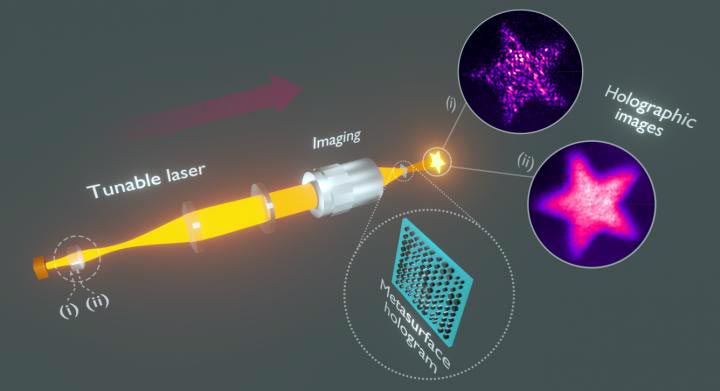Suppressing meta-holographic artifacts by laser coherence tuning

Illustration of the tunable laser source, meta-hologram and projected holographic images.The laser is tuned by gradually translating a single lens inside the laser cavity (dashed circle), allowing to precisely control the laser beam coherence. The beam is focused by an imaging system to a meta-surface hologram (dotted circle) that shapes the beam into an image of a star (solid circle). When the in-cavity lens is translated to position (i) a single mode lases inside the cavity, producing a degraded image full of artifacts due to coherent interference [inset (i)]. When the lens is set to position (ii), the laser is tuned to produce an optimized amount of modes, leading to a holographic image that contains very little artifacts while maintaining its sharp details [inset (ii)].
Credit by Yaniv Eliezer, Geyang Qu, Wenhong Yang, Yujie Wang, Hasan Yilmaz, Shumin Xiao, Qinghai Song and Hui Cao
Metasurface holograms (meta-holograms) are ultra-thin artificial surfaces designed to shape incident light and project it to extremely wide angles. Meta-holograms have opened up numerous possibilities such as light multiplexing, information processing, 3D display, high-density data storage, and optical encoding.
Despite of these remarkable advances, the road to practical applications of meta-holograms is hindered by artifacts that originate from strong interactions between the building blocks of the meta-holographic surface and inevitable fabrication defects, ultimately causing distortion and degradation to the holographic image. The small dimensions of the meta-hologram, together with the random nature of fabrication defects, make the artifacts problem extremely difficult to correct.
In a new paper published in Light Science & Application, a team of scientists, led by Hui Cao from Yale University, USA, Qinghai Song and Shumin Xiao from Harbin Institute of Technology (Shenzhen), China, and co-workers have developed an efficient method to suppress the holographic artifacts while maintaining the image quality. Their method is based on fine-tuning of the coherence of illumination, implemented with a degenerate cavity laser, a unique class of lasers which allows a precise and continuous tuning of the spatial coherence of emission with little change in total power and temporal coherence.
The majority of lasers operates with a single or a few spatial modes, and produces highly coherent emission. When the laser light is used to illuminate a meta-hologram, the interference of scattered waves produce coherent artifacts and severely distort the images. The scientists gradually decrease the coherence of laser illumination to amend the holographic artifacts. However, if the coherence is too low, the fine details of the holographic image will blur. Thus it is essential to find the optimal degree of coherence to suppress artifacts without a significant loss of spatial resolution. This was realized with a novel laser source whose spatial coherence of emission can be tuned gradually, accurately and efficiently.
The scientists summarize the operational principle of their novel technique:
“We design a bright laser source with a precise and continuous tuning of the spatial coherence. The tuning is remarkably energy efficient with low power variation. The laser is then used to illuminate a meta-hologram. The precise tuning allows reaching the right level of coherence required to suppress the coherent artifacts without significant blurring of the holographic image.”
“Compared to the existing methods of lowering the coherence of conventional lasers, our degenerate cavity laser exhibits extremely fast decoherence, thus enabling high-speed artifact-free meta-holography with no pre- or post-processing of any kind.” they added.
“The new method can be used to dramatically enhance the image quality of compact, dynamical holographic projection displays. This breakthrough will open a new venue for future applications of meta-holograms in augmented reality, optical storage, beam multiplexing, nonlinear holography and optical manipulation.” the scientists forecast.
Related Journal Article
Media Contact
All latest news from the category: Physics and Astronomy
This area deals with the fundamental laws and building blocks of nature and how they interact, the properties and the behavior of matter, and research into space and time and their structures.
innovations-report provides in-depth reports and articles on subjects such as astrophysics, laser technologies, nuclear, quantum, particle and solid-state physics, nanotechnologies, planetary research and findings (Mars, Venus) and developments related to the Hubble Telescope.
Newest articles

Recovering phosphorus from sewage sludge ash
Chemical and heat treatment of sewage sludge can recover phosphorus in a process that could help address the problem of diminishing supplies of phosphorus ores. Valuable supplies of phosphorus could…

Efficient, sustainable and cost-effective hybrid energy storage system for modern power grids
EU project HyFlow: Over three years of research, the consortium of the EU project HyFlow has successfully developed a highly efficient, sustainable, and cost-effective hybrid energy storage system (HESS) that…

After 25 years, researchers uncover genetic cause of rare neurological disease
Some families call it a trial of faith. Others just call it a curse. The progressive neurological disease known as spinocerebellar ataxia 4 (SCA4) is a rare condition, but its…





















